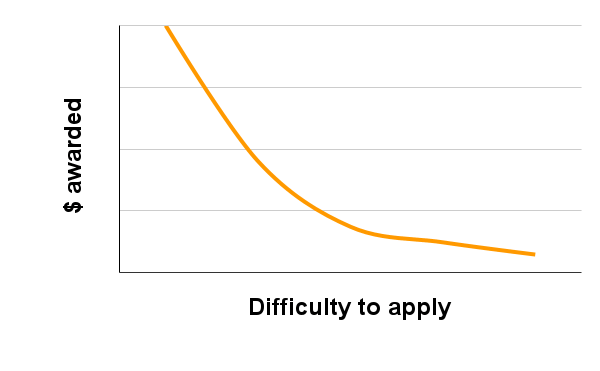This lesson covers...
The essential information you need to track down the private scholarships that you will be most likely to win.
Time
12 minutes
30 minutes optional work time
By the end you should...
Be comfortable with at least three ways to find private scholarships
Have two to four scholarships in your scholarship tracker
Remember that Duck Tape Prom Dress Scholarship from last section? That’s just one example of a type of scholarship—company-sponsored—that can fall into the category of private scholarships.
Coca Cola, Dr. Pepper, and Burger King are just some of the companies that sponsor scholarships. (Wendy’s used to too but now the Heisman High School Scholarship is its own thing.)
Each scholarship has different requirements and its own deadline.
Any scholarship not awarded by a specific college and not limited to applicants in your hometown or area falls into this category.
So besides big corporations, who else offers these scholarships?
Anyone with money.
Here are some examples:
Employers
Fraternities and sororities
Organizations
Individuals
And have you ever heard of the Zombie Survival Scholarship? Yep. That exists. Private scholarships’ only limitations are made by the folks who create them.
Pros of private scholarships:
Variety: So. Many. Scholarships.
Availability: Unlike institutional scholarships that are attached to a specific college, private scholarships generally follow you wherever you go.
Stackability: You could hypothetically cover your entire college bill with these scholarships. It would take a lot of work though—and the probability of most students doing so is pretty low. Which brings us to...
Cons of Private Scholarships:
No Comprehensive List: While I truly wish there was one searchable database that had every single private scholarship, it simply doesn’t exist. One of the main reasons for this is because scholarships have different lifespans—some well-known or really big scholarships have been around for a long time and are in virtually every list of scholarships, while others pop up one year but within a couple years cease to be funded.
Applicability: Finding multiple scholarships that work for you can be tough. For every 100 random scholarships you look at, you’ll probably be eligible for 1 or 2. And, depending on when you look, their application deadlines may have already passed.
One-shots: Most private scholarships are single-time awards, meaning you have to figure out how to cover the difference next year.
And arguably the most annoying-–and sneaky!—aspect of these scholarships…
Negative impact on your institutional aid: outside scholarships like private and local scholarships can result in a college decreasing the free money they give you! This varies by school and situation, so just be aware that it could happen.
With these obstacles in mind, how can I know if looking for and filling out a scholarship is worth my time?
In an ideal world, you would apply for every scholarship for which you’re eligible. That said, I understand your time (especially as a senior) is limited.
With this in mind, here are two things to consider:
Be sure to employ your team. Ask adults to help find scholarships for you to apply to.
Narrow your “apply to” list by considering two criteria: the eligibility pool size and the work-reward ratio.
Diving into the Eligibility Pool
When considering applying for a scholarship, ask yourself: “How many people could apply for this scholarship?”
If you’re the only one in your high school’s senior class who is eligible, OMG do it.
If you’re one of a handful, I’d go for it.
About a half of your class could apply: it’s your call.
If literally anyone with a pulse is eligible, you could consider passing.
Weighing the Work-Reward Ratio
Generally, the harder the application is and the lower the award amount, the less competitive a scholarship will be and, therefore, the more likely you are to win it!
Scholarship Level of Competition Function Graph
A $500 award that requires 3 essays, 6 letters of recommendation, and a blood sample is unlikely to get many takers.
“Enter your email to win $1,000,000 for college!” likely has literally millions of applicants.
Amanda Soap Box Moment
Along these lines, you’ll also want to factor in the time trade-off. Let’s say you work at the local burger joint and earn $10/hour. It will take you 100 hours (five 20-hour weeks) to earn $1,000. And that’s before taxes!
Now consider this: How long will it take you to fill out a “normal” scholarship application? Surely not 100 hours. Likely not even 10 hours. Maybe an hour or two tops.
Bonus: the more you apply for, the quicker you’ll get at applying.
So how many of these “one or two hour” applications should I be trying to do?
As many as you like. In fact, you could spend your whole “paying for college” journey dedicated to just this section. And many students do. (Seriously, you could spend every spare moment from today until you graduate from college—including graduate school!—searching for these things and still not reach the bottom of the barrel.)
But you probably shouldn’t.
In fact, these scholarships are just the tip of the proverbial iceberg. There’s so much more to financial aid and none of it is nearly as time-consuming as navigating the Wild West of online private scholarships.
So while I fully support you riding out, guns-blazing in your quest to win private scholarships, I’d encourage you to take some breaks to investigate other components of the “paying for college” process that are far more straightforward and, for all but a small fraction of students, yield way more money. (See literally any other section of this guide.)
For now, let’s finish up by discussing where you should spend your time looking for private scholarships to yield the best results.
#1 Scholarship Question Ever: Where do I find scholarships?
The internet.
I’m not being snarky. Google is your best friend when it comes to scholarships. Take that list of all the words that describe you (you know, the Action Item you totally didn’t skip from the last section) and put it to work.
More specifically there are several scholarship sites you can use. Here are some of the most-user friendly scholarship search engines.
Bonus for BIPOC Students: UNCF.org
Pro Tip: Don’t feel like you have to register for a website to use its search engine. You can. But once you find the name of a scholarship, you can ususally just Google it.
Also, be sure to check out if your state has a resource for scholarships specifically for students in your state.
Here are some examples of states with their own scholarship resource:
Finally, check out any group/organization you or your family is affiliated with.
Student Employers (e.g. Chick-Fil-A)
Parent Employers (e.g. Chevron)
Parents’ Employers’ Unions (e.g. American Federation of Teachers)
Military (e.g. ROTC or Yellow Ribbon)
National Organizations (e.g. Boy Scouts of America)
Fraternities/Sororities (e.g. AKA Scholarships)
Religious organizations (e.g. The South Carolina Baptist Convention)
Finally, if you have any interest in serving in the armed forces--and are reading by fall of your senior year—an ROTC scholarship may be for you! This type of scholarship is funded through a partnership between the branches of the US military (Army, Navy, Marine Corps, Air Force, and Space Force) and a college, so only certain colleges have certain ROTC programs. The three programs are Air Force ROTC, Army ROTC and Navy ROTC.
Need an incredible—but also very concise—summary about these scholarships? Here’s one by our friend Lisa Rielage, veteran and owner of Admissions Decrypted. Need more information? You got it.
Also, while it’s not exactly a “scholarship,” it’s worth noting that the military does include benefits like educational funding for those who join. We don’t want to get too far down that rabbit-hole here, but I’m certain there is a recruiter who’d love to talk all about it—likely at great length—with you.
[action_item]
Action Item: Choose a quality from your list. Set a timer for 30 minutes. Search online—using Google or the scholarship search engine of your choice—and add any scholarship you are eligible for to your scholarship tracker database. You should find one, maybe two. Congratulations if you score more!
Bonus Action Item: If you’re a student who qualifies for Free/Reduced Lunch or SAT/ACT Fee Waivers and has good grades (usually 3.5+ GPA), you should definitely take a minimum of 30 minutes to rule in/out these incredible scholarship programs. #FullRides #MultipleWinnersForEach
Jack Kent Cooke: For awesome students like you
Scholarship Amount: up to $40,000 per year (that’s $160,000!!!)
Who’s eligible: basically anyone like you
Deadline? October of Senior year
Other info: There’s a whole program for students that starts in 8th grade!
Questbridge: For students with tip-top grades
Scholarship Amount: a full ride to one of these colleges
Who’s eligible: Students with great grades like you
Deadline? September of Senior year
Other info:
You apply to up to 12 colleges through one application.
They also have a program for juniors in high school to help them really succeed with the whole college process!
The Gates Scholarship: For students of color
Scholarship Amount: basically a full ride
Who’s eligible: BIPOC students like you. Applicants must be Pell Grant eligible.
Deadline?
September 15th - Initial Phase One application is due at 5pm PT
December 1st - 2,000 Semi-Finalists will be announced and will be invited to complete Phase II of the application which includes essays, recommendations, and additional document verification (more on that in Part Two of this post)
March 1st - 600 Finalists will be announced and invited to interview
April 20th - The 300 Gates Scholars will be announced
For more, see here.
Essay: see here.
POSSE: For students who are leaders
Scholarship Amount: covers tuition to one of these colleges
Who’s eligible: Student-leaders in 10 of the US’s largest cities
Deadline? Varies by city so get nominated early (junior spring/senior summer)
Other info: You gain a whole support network for college starting in January of your senior year.
Bonner Scholars: For students who serve their communities
Scholarship Amount: it varies by the college, but typically a full ride!
Who’s eligible: Students committed to community service
Deadline? Again, varies by college
Other info: To maintain your scholarship, you’ll complete a certain number of service hours each week while you’re in college.
Golden Door: For students who are not US Citizens
Scholarship Amount: Covers all costs at one of the partner schools
Who’s eligible: Students who have DACA, TPS or are undocumented, meaning currently do not have lawful status in the US.
Deadline? Not always posted on the website but it’s September.
Hispanic Scholarship Fund: For students of Hispanic descent
Scholarship Amount: ranges from $500 to $5000
Who’s eligible: People of Hispanic heritage. GPA requirement is 3.0/4
Deadline? Feb 14
The Jackie Robinson Foundation Scholarship Program: This goes beyond scholarships and includes mentoring throughout a student’s college career
Scholarship Amount: “JRF Scholars receive grants of up to $30,000 over four years to complement the financial aid they receive from their colleges or universities”
Who’s eligible: The JRF “uses the U.S. Census Bureau definition of minority. If you feel that you are part of a minority group, we encourage you to apply.” Check here for more.
Deadline? Due February 1
Up Next
After all this searching, wouldn’t it be lovely if there was a straightforward list of scholarships that only people from your high school (or the local area) could apply for?
There probably is.
And that’s what we’re going to tackle in the next section: local scholarships—which are far easier to find and win.
Previous












